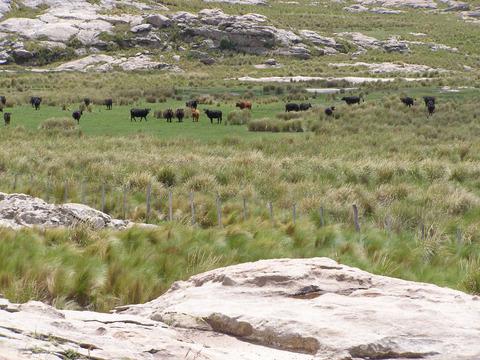当前位置:
X-MOL 学术
›
Austral Ecol.
›
论文详情
Our official English website, www.x-mol.net, welcomes your
feedback! (Note: you will need to create a separate account there.)
Plant and soil carbon stocks in grassland patches maintained by extensive grazing in the highlands of central Argentina
Austral Ecology ( IF 1.6 ) Pub Date : 2020-12-26 , DOI: 10.1111/aec.12992 María Victoria Vaieretti 1, 2 , Georgina Conti 1 , María Poca 3 , Esteban Kowaljow 1, 2 , Lucas Gorné 1 , Gustavo Bertone 1 , Ana María Cingolani 1 , Natalia Pérez‐Harguindeguy 1, 2
Austral Ecology ( IF 1.6 ) Pub Date : 2020-12-26 , DOI: 10.1111/aec.12992 María Victoria Vaieretti 1, 2 , Georgina Conti 1 , María Poca 3 , Esteban Kowaljow 1, 2 , Lucas Gorné 1 , Gustavo Bertone 1 , Ana María Cingolani 1 , Natalia Pérez‐Harguindeguy 1, 2
Affiliation

|
Grasslands are valued by their capacity to store carbon (C) as well as by their livestock production. However, focussing grassland management on one of these characteristics might negatively affect the other. Here, we describe for the first time the amount of C stored in the plant and soil compartments of extensively grazed highland grasslands of central Argentina. We quantified C stocks of standing plant, litter, and roots biomass, and soil (0–100 cm depth) in three coexisting grassland types associated with different livestock use: lawns and open and closed tussock grasslands (from higher to lower grazing use) and analysed how those stocks vary across grassland types. Our main results showed that these mountain grasslands represent an important regional C reservoir, with total C stocks (plant plus soil) ranging from 110 to 472 Mg C ha−1, with more than 95% of C being stored in soils. Differences in soil C stocks up to 30 cm depth were not associated with grassland types. However, in grazing lawns (higher livestock use), belowground plant C increased, whereas aboveground plant C was reduced. Overall, resulting in a 14% lower C stored in the plant‐soil system up to 30 cm depth than in tussock grasslands. Our study shows that highland grasslands of central Argentina maintain huge soil C reservoirs. However, livestock use could reduce surface C stocks by affecting the plant biomass compartments, which could have a long‐term effect on soil C stocks. These findings have direct implications for mountain grasslands management and conservation in the context of climate change mitigation.
中文翻译:

阿根廷中部高地的广泛放牧维持了草原地区的植物和土壤碳储量
草原因其储存碳(C)的能力以及畜牧业而受到重视。但是,将草地管理重点放在其中一个特征上可能会对另一个特征产生负面影响。在这里,我们首次描述了阿根廷中部广泛放牧的高地草原的植物和土壤隔间中储存的碳量。我们对与牲畜使用相关的三种共存草地类型中的立足植物,凋落物和根系生物量以及土壤(0–100 cm深度)的C储量进行了量化:草坪和开放和封闭的草草地(从高放牧到低放牧使用)和分析了这些种群在不同草地类型之间的变化。我们的主要结果表明,这些高山草原是重要的区域性碳库,碳储量(植物加土壤)的总量在110至472 Mg C ha之间。-1,其中95%以上的C储存在土壤中。高达30 cm深度的土壤碳库差异与草地类型无关。但是,在放牧的草坪上(较高的牲畜使用量),地下植物C增多了,而地下植物C减少了。总体而言,与草丛草地相比,在深达30 cm的植物-土壤系统中储存的碳降低了14%。我们的研究表明,阿根廷中部的高地草原保持着巨大的土壤C储层。但是,牲畜的使用可能会通过影响植物生物量区室来减少地表C储量,这可能对土壤C储量产生长期影响。这些发现对缓解气候变化的山区草地的管理和保护具有直接的意义。
更新日期:2020-12-26
中文翻译:

阿根廷中部高地的广泛放牧维持了草原地区的植物和土壤碳储量
草原因其储存碳(C)的能力以及畜牧业而受到重视。但是,将草地管理重点放在其中一个特征上可能会对另一个特征产生负面影响。在这里,我们首次描述了阿根廷中部广泛放牧的高地草原的植物和土壤隔间中储存的碳量。我们对与牲畜使用相关的三种共存草地类型中的立足植物,凋落物和根系生物量以及土壤(0–100 cm深度)的C储量进行了量化:草坪和开放和封闭的草草地(从高放牧到低放牧使用)和分析了这些种群在不同草地类型之间的变化。我们的主要结果表明,这些高山草原是重要的区域性碳库,碳储量(植物加土壤)的总量在110至472 Mg C ha之间。-1,其中95%以上的C储存在土壤中。高达30 cm深度的土壤碳库差异与草地类型无关。但是,在放牧的草坪上(较高的牲畜使用量),地下植物C增多了,而地下植物C减少了。总体而言,与草丛草地相比,在深达30 cm的植物-土壤系统中储存的碳降低了14%。我们的研究表明,阿根廷中部的高地草原保持着巨大的土壤C储层。但是,牲畜的使用可能会通过影响植物生物量区室来减少地表C储量,这可能对土壤C储量产生长期影响。这些发现对缓解气候变化的山区草地的管理和保护具有直接的意义。











































 京公网安备 11010802027423号
京公网安备 11010802027423号